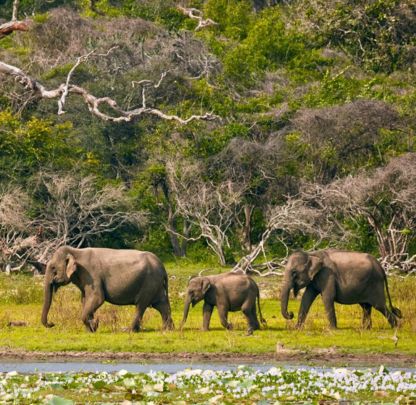Introduction
While Sri Lanka is very well known for its exotic beaches, lush tea estates, scenic hill country and warm hospitality, its large elephant population is also a renowned fact. There are a few elephant sanctuaries such as the popular Pinnawala elephant orphanage and the Udawalawe Elephant Sanctuary, however, the better way to enjoy elephants in their natural habitat is to get into the wild and include National Parks in your Sri Lanka tour itinerary. Safaris within the lavish jungles of Sri Lanka offer an authentic experience of observing elephants.
The Sri Lankan authorities such as the Ministry of Agriculture and the Department of Wildlife recognize the cultural and natural significance of the elephant species and are thus continuously striving to ensure survival and good health of both wild and domesticated elephants in Sri Lanka. The sizeable population of elephants comprise of native elephants that are a completely different sub species. According to the Department of Wildlife, there are over 7000 wild elephants existing.
Below is a summary of the places where wild elephants can be seen in Sri Lanka.
1. Minneriya National Park
NatGeo featured Minneriya National Park in “The Gathering” – the world’s most breathtaking natural phenomenon of elephant gatherings that occurs within its vibrant landscapes. Originating from the Minneriya Tank, this congregation of wild elephants remains for hours together, allowing visitors to admire the gentle giants as they frolic and graze in the open fields. June to September is a good time to enjoy this excursion and observe a spectacle of around 200-500 elephants in one area!
2. Wilpattu National Park
Wilpattu is the one of the oldest and undoubtedly the largest National Park in Sri Lanka. The park has 106 natural lakes, also known as ‘willus’ spread throughout its area. When rain is lacking, elephants are attracted to these pools of water, thus guaranteeing elephant sightings for visitors. Kids will enjoy this rugged safari ride through uneven terrain, navigating past shrubs and muddy puddles, and trying to spot elephants and the leopard if they are lucky enough!
3. Lahugala Kitulana National Park
This one is the smallest national park in Sri Lanka but is a fantastic excursion from the east coast beach of Arugam Bay. Although small in size, Lahugala Kitulana National Park is an important habitat for endemic birds and Sri Lankan elephants. If you are looking for an off-the-beaten destination for elephant sightings, this park is a good option.
4. Udawalawa National Park
Udawalawe National Park is the third most visited Park in Sri Lanka and is home to a diverse spectrum of animals. The main attraction here are the elephants, with a herd of 600 to 700 elephants believed to be permanent residents of the park. Apart from that, Udawalawe is known for its bird species including the endemic Toque Macaque and other endemic species along with fish, reptiles and amphibians.
The Udawalawe Sanctuary also deserves a shout out here – a transit home where baby elephants are isolated and rehabilitated until they are independent and capable to be released back into the wild.
5. Gal Oya National Park
Gal Oya National Park offers a unique opportunity to observe elephants swimming in the Gal Oya reservoir via a one-of-a-kind boat safari experience. As the most untouched of all of Sri Lanka’s national parks, the boat safari offers views of swimming elephants, basking crocodiles, and an up-close encounter with bird species.
Good to know: Habits and Lifestyle of Sri Lankan Elephants
Sri Lankan elephants are highly social – and are known to form herds of 12-20 individuals at a time. Each of these social units are comprised of related females, led by the oldest female in the group. Herds are formed in two types: one is for nursing – made up of lactating mothers and their babies. The other type is as juvenile care units – containing females and juveniles. These migratory elephants travel on strict routes in between the wet and dry seasons. The oldest member of the herd usually memorizes the route and guides the rest of the group.
Fun Facts about elephants
- Elephants are highly intelligent animals, possessing the largest brain of all terrestrial mammals in the world.
- Sri Lankan elephants can recognize themselves in a mirror!
- Elephants have a thick skin – up to one inch. However, their skin is highly sensitive to the sun, which is why they cover their body with dust or mud to protect their skin.
- An elephant trunk is multifunctional – helps with breathing, smelling, drinking, holding objects and calling out to others.
- Although massive, even an ant can disturb elephants!
- An elephant trunk has nearly 100,000 muscles, and a number of sensitive nerve endings that can be triggered by something as small as an ant!
How to plan your Sri Lanka tour itinerary with the best of elephants?
Interested in making the most of the elephant species in Sri Lanka? Just get in touch with our team of friendly travel consultants and we will curate a wildlife tour in Sri Lanka for you, including all the above destinations as well as additional beach and hill country excursions in order to make the most of your holiday in Sri Lanka!

